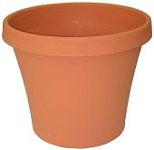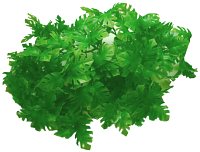Equipment
Snails can be kept in a variety of tanks and containers. It must be large enough to accomodate them, with good ventilation. The snails need light so an opaque box is out of the question but a translucent/nearly transparent container will be fine from the snails point of view.
The most important thing to remember is that it must be escape-proof. Snails are extremely strong (they can lift 10-50 times their own weight!) for their size and could lift a lid that isn't clipped or weighted down. Wooden or cardboard containers are not suitable, they will rot and in the case of cardboard, the snails will actually eat it.
Housing

Plastic 'Pet-Pal' Style
It's hard to find large versions of these, the biggest we know about is: 44 x 30 x 30 which is just big enough for two African Land snails. These cost about £10-15.
The lid snaps on tightly and has lots of holes in the lid for good ventilation. The perspex/acrylic is perfectly transparent. They are easy to scratch so they must be cleaned with a soft cloth or sponge. Very light. The smaller ones can be used for hatching eggs and the larger ones will house a number of juveniles. Want to know how many? If so, click here.

Plastic Storage Container
Available in all shapes and sizes from most supermarkets, DIY stores etc. Very cheap at around £2-10 and easy to clean. Shop around for the most transparent you can find. Some are more cloudy than others, even within the same product range. If you find one that is suitable it's worth comparing it with others next to it, there just may be a more transparent one there.
Holes need to be drilled in the top and/or round the top of the sides for ventilation. Due to the cost and the material they're made from a number of interesting things can be done to these (see here). The top may need to be secured if it doesn't snap shut.
It's usually worth having a few of these around for general snail care, they are cheap, can be used to store peat and they make good emergency tanks.

Glass Aquarium
Expensive and heavy, meaning more hassle when you're cleaning them out. They don't stand up to serious punishment but they are perfectly clear and don't scratch easily. It's probably worth asking your local aquarium shops if they have any damaged ones as you don't need it to be water-tight.
You may have to secure the top because most aquarium lids just rest on the rim. Choose one with a plastic lid, because if it doesn't have holes it will need drilling.
Also, if you choose one with a bulb fitted in the lid make sure the heat isn't excessive and isn't reachable by the snails, or they could burn themselves. Also, if you decide to use a heat-mat, glass transmits heat more efficiently than plastic.

Plastic Storage Container
Probably the 'holy grail' of snail tanks. The are extremely hard to find and are more expensive than glass at small to medium sizes. They tend to be made of very thick perspex because they are designed to hold water.
They are tough and durable but they do scratch easily so they must be cleaned with a soft cloth or sponge. You will probably need to drill holes in the lid for ventilation.
Ventilation and Heating
Heating
Snails need a damp environment kept between 18-30 °C (64-86 °F) although they generally do best at between 21-23 °C (70-74 °F). For most people, that is normal room temperature. Some types of snails do better at higher temperatures of up to 26°C. If you are struggling to maintain the required heat or you need an extra boost for winter then it is worth purchasing a heat mat.


There are a variety available in all sizes. You should aim to cover one third to one half of the tank. This means the snails can move away from the heat if it is too excessive. You can get thermostats for heat mats but in most cases this is unnecessary. They are expensive and because heat mats are very low power they only provide a gentle heat, raising the temperature by a few degrees.
Most heat mats work by heating up wherever they are pressed so they should be in contact with the side of the tank. The side is the best place because putting it under the tank may cause a few problems. The substrate will insulate the heat from the air and just heat up, meaning the snails can't burrow, it will dry out very quickly and in some cases can cause the heat-mat to overheat.
Simply fix the heat mat to the side of the tank, with a sheet of polystyrene at least 5mm thick on the back. This insulates the back and forces the heat out through the tank side.
For plastic storage crates, you may find that to allow the heat in, holes need to be drilled where the heat mat will be placed. In some cases the plastic container will be nearly as good at insulating as the polystyrene and the heat won't get through or perhaps not enough. The container could be curved slightly so it is hard to attach flush to the side. Little holes will improve this. However, it will never be quite as good as when attached to a glass tank.
Note: Certain species are more sensitive to changes in conditions than others. In particular are members of the genus Archachatina. Some seem to do well at conditions similar to other species but many, not just wild-caught ones, seem to require more heat and more specialist conditions. Alternatively, if we have any specific information regarding this for each species you will find it in the species pages. You can find those here.
Humidity & Ventilation
Snails like damp, but not extremely wet, environments. The substrate needs to be damp, i.e. it should stick easily to your hand but there shouldn't be puddles of water everywhere. Moisture like this, will soon go sour. Once the substrate is moist, spraying in the morning and at evening will help to maintain the conditions you need. A dish of water placed in the tank, will help to keep the humidity up.

For the more scientific among you snails prefer between 70-95% rH (relative humidity). 80-90% is more than likely ideal. rH is the measure of how much moisture the air is holding compared to how much it can hold at a given temperature. So a rH of 90% means the air is holding 90% of the moisture it could hold. When the temperature goes up, the air can hold more.
Using a heat-mat will cause the air to warm up and suck more moisture from the substrate. You don't want condensation hanging around. That is probably too humid. If your heating goes off and the heat mat is on, expect a little, as the warm air in the tank condenses on the cold sides. This is controlled by ventilation, if you find it just drips, your tank is too wet for the ventilation it has. Heat and humidity is a 'forcing house' for bacteria. If it is growing excessively you need to increase ventilation.
You can buy analog temperature and humidity (called hygrometers) gauges for about £1.50 each. Analog ones are better than the more expensive digital ones; they tend to be more accurate, less sensitive to quick fluctuations and don't have areas near the sensors that can harbour condensation. You can also get min/max versions which show you what extremes were reached from when you last reset it.
This may seem a little scary but it is actually very easy to maintain the correct conditions. Sensors aren't needed. In time you will instinctively know what is right. This information is merely here for those having problems and for reference purposes. In the wild, snails can cope with slowly fluctuating temperatures and humidity.
Decoration
There are a wide variety of ways to decorate your tank to make it more interesting. The most important thing to remember is to avoid, hard materials like ceramic dishes, stones and bricks etc. If a snail takes a fall and hits something hard it will damage its shell. This does happen from time to time, so softer materials in the tank will mean less damage, making it easier for the snail or you to repair. For more information regarding shell repair click here.



Plant Pots
Plant pots are the ideal hiding place for snails.
Make sure you choose a plastic or polythene one so there is less likely to damage your snails' shells if they are victim to a fall.
Simply turn the pots on their side either in one piece or cut in half. Alternatively, you could cut a door into it and place it upside down.

Fake Plastic Plants
Makes the tank look more attractive and natural and you can use it to provide some good hiding places, especially for juveniles. Easy to clean.
One large 'bush' can be cut into smaller pieces to make it easier to arrange.
Too thin and flimsy for larger snails to climb on, including the wired ones.
A large trailing plant will cost you about £5-10.

Cork Bark
Brilliant addition to a tank. The snails love to hide in, around and under it. Cork bark is one of the most water-resistant barks available. It won't rot easily so it will last a long time. It's also easy to clean.
Cost around £1/100g.

Tree Branches
Anything you put in the tank that gives the snails something to climb on essentially increases the usable area of the tank. Wooden branches like those you may find in a reptile tank are ideal. You can buy specially hardened Java wood branches that are safe to use.
However, you can create your own very easily. They do rot in time but they are easy to clean and can be dried in the oven. Eventually they will need to be replaced unless they are treated. However, this is inadvisable because most treatments will disintegrate in damp conditions and we have no way of knowing whether this will adversely affect the snails.

Live Plants
Live plants are a fantastic addition to the tank but can be tricky to maintain. You need to choose plants that can cope with high humidity and low light levels such as privet, ivy, ficus or plants used in terrariums and bottle gardens.
Expect the plants to be eaten a little and you must check for eggs because the snails may lay eggs around the foliage and/or roots.
Privet is a particularly good choice, it's fast growing, evergreen (deciduous in very cold conditions), very tolerant of a wide range of conditions and the snails don't seem particulary interested in eating them. They can be found everywhere and you can take a cutting simply by cutting a branch off and putting it in water; within a few weeks it will have roots.
If you want a plant that is eaten by the snails check out this list of plants that African Snails have been found eating in the wild.
Miscellaneous
Food/Water dish
Providing a food dish is a good idea. It helps to keep food off the soil which aids in keeping the tank free from pests. It also makes the daily change over of food much cleaner and simpler.
Providing a waterdish for your snails is not necessary but it does keep the humidity up. It also provides them with a supply of water if they want it and they do like to sit in it.
Ideally, you want a shallow dish that is heavy so they can't tip it over but also not hard because a fall onto it will damage their shells. In a perfect world such a dish would be readily available but alas, we have to make do with what we can get. A large shallow dish will be much more 'tip-proof' than a tall sided one. It is best to start with a plastic one and see how you get on. If they tip it over and you can't really accomodate one, it's time to move to something heavier. It doesn't seem wise to choose a ceramic one unless you have to, especially since juveniles will probably not manage to tip a plastic one over.
If you are having this problem there are a number of things you can do:
- Stick it to the bottom of your tank with blue-tack.
- Stick something heavy to bottom of your dish.
- Use a ceramic dish but make a cover out of a plastic plant pot.

The tank on the left uses a little 'rock-effect' drinking bowl - the type that are sold in reptile shops. They are graduated so that your snail will not drown, and flat so the snail will not tip them up.

Resin Reptile Dish
These are good because they are shallow, fairly heavy and made from resin so they aren't as hard as pottery. These cost about £3.
